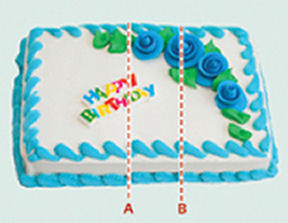- More than 2 years ago
Sometimes, a birthday celebration goes awry when a pair of partygoers squabble over the cake, both preferring the slice with the cherry or with the thickest icing. That sort of spat caught the attention of mathematicians, inspiring a new idea for making divisions fairly.

The problem hinges on the definition of fair. Steven Brams of New York University and his colleagues propose that a division is fair if, after it’s made, each person’s assessment of the value of his or her piece is the same. In the December Notices of the American Mathematical Society, the team reports a new method of cake cutting that ensures this result.
The classic way for two people to share a cake without argument is known as “I cut, you choose.” To divide an elaborately decorated sheet cake strewn with nuts and coconut, I’d cut the cake into two pieces that seem to me to be of equal value, though not necessarily equal size. If I particularly like nuts, for example, I would divide the cake into unequal pieces, the smaller piece getting more nuts, to make sure that I’m satisfied with whichever slice remains after you’ve made your choice.
But, that division might not provide pieces that we value equally, thus being unfair by Brams’ definition. Although from my perspective, either piece is half the value of the cake, the slice you choose may, from your perspective, be much more than half the cake’s value. For example, if you like coconut, the bigger, less nutty slice might have extra value if it has more coconut than the other.
Brams’ new procedure avoids this problem. You and I each report to a third person—a referee—how we value the cake. The referee then finds the place where I would choose the cake to be divided into two shares of equal value and the place you would choose.
If the two spots are the same, the referee divides the cake there, and we’d each be satisfied with our shares. But suppose the two spots are different. The referee would assign to me whatever portion of the cake stretches from my selected spot to the end of the cake but doesn’t include your spot. The referee would do the same for you. That would give us each what we regard as half the cake’s value. Then, the referee would divide the leftover bit, giving us each a bonus that we value equally.
Brams says, “The cake is really a metaphor for any heterogeneous good where different people value it differently.” A practical example might be the joint property to be divided in a divorce.
James Tanton, a mathematician at St. Mark’s School in Southborough, Mass., calls the work exciting but cautions that it’s not very useful. “I don’t know if anyone other than me has actually brought a cake in and tried to divide it,” he says. “It’s impossible, because human beings … change their minds.”






